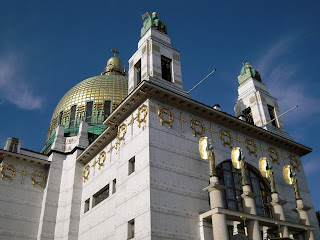
A Church for All
 Kirche am Steinhof sits on the edge of the Vienna Woods, 1017 feet above sea level, so the gold dome atop the white marble edifice can be seen from all parts of the city. (An extensive 2006 refurbishing included a total of nearly five pounds of gleaming gold gilding for the 105-foot cupola.) This church’s placement is unusual, not because of the height, and not because of the close proximity to the woods, but because it is the focal point of Vienna’s largest public psychiatric hospital. At the turn of the century, Viennese psychiatric theory and practice recommended natural healing environments for patients. This inspired the creation of a 274-acre mental health facility, surrounded on three sides by the lovely Wienerwald. In 1902 Otto Wagner himself designed the ground’s layout and many of its 60 buildings including a theatre where performances are still given.
Kirche am Steinhof sits on the edge of the Vienna Woods, 1017 feet above sea level, so the gold dome atop the white marble edifice can be seen from all parts of the city. (An extensive 2006 refurbishing included a total of nearly five pounds of gleaming gold gilding for the 105-foot cupola.) This church’s placement is unusual, not because of the height, and not because of the close proximity to the woods, but because it is the focal point of Vienna’s largest public psychiatric hospital. At the turn of the century, Viennese psychiatric theory and practice recommended natural healing environments for patients. This inspired the creation of a 274-acre mental health facility, surrounded on three sides by the lovely Wienerwald. In 1902 Otto Wagner himself designed the ground’s layout and many of its 60 buildings including a theatre where performances are still given. Our favorite tourbook, Time Out Vienna, stated Wagner’s hope that his church would be a shrine for all religions. Wagner felt that all patients, regardless of religious affiliation, deserved to have a beautiful place of worship where they would feel comfortable. To that end, he took great care in the design of even the smallest details. While in the planning stage, Wagner consulted with psychiatrists to be certain his church would be comfortable for all worshipers, particularly those with mental and neurological health challenges. The church was built between 1904 and 1907, with very practical features such as numerous and easily accessible bathrooms, special emergency exits, a room for a doctor and emergency staff, pews of different widths with no sharp edges (for comfort and safety), continuously flowing holy water instead of a basin (more sanitary), a slightly raked theatre-type floor for easy viewing of the altar even from the back pews, and tile covering most surfaces (clean-up is a breeze!).
Our favorite tourbook, Time Out Vienna, stated Wagner’s hope that his church would be a shrine for all religions. Wagner felt that all patients, regardless of religious affiliation, deserved to have a beautiful place of worship where they would feel comfortable. To that end, he took great care in the design of even the smallest details. While in the planning stage, Wagner consulted with psychiatrists to be certain his church would be comfortable for all worshipers, particularly those with mental and neurological health challenges. The church was built between 1904 and 1907, with very practical features such as numerous and easily accessible bathrooms, special emergency exits, a room for a doctor and emergency staff, pews of different widths with no sharp edges (for comfort and safety), continuously flowing holy water instead of a basin (more sanitary), a slightly raked theatre-type floor for easy viewing of the altar even from the back pews, and tile covering most surfaces (clean-up is a breeze!). 
Although practical, the church is also visually stunning and filled with thoughtful symbolism. For instance, the elaborate and colorful mosaic behind the ornate altar represents the reception of the departed soul into heaven. Those saints attending the celebration include Saint Dymphan the patron saint of those afflicted by epilepsy or mental illness and Saint Clement Hofbauer, the patron saint of Vienna.




In another stroke of genius, the church sits on a north-south axis, so light pours in the magnificent windows created by Koloman Moser, friend of Wagner and an art nouveau master. Each of the seven window panels portrays a saint, each fulfilling Christ's physical and spiritual commands (feed the hungry, visit the sick, etc.); above the saints fly a pair of angels (with awesome wings) who are holding a quotation from the Gospel of Matthew “whatever you did for one of the least of these brothers or sisters, you did for me.”




(We particularly like this photo because you can also see the one of the chandeliers.)





No comments:
Post a Comment